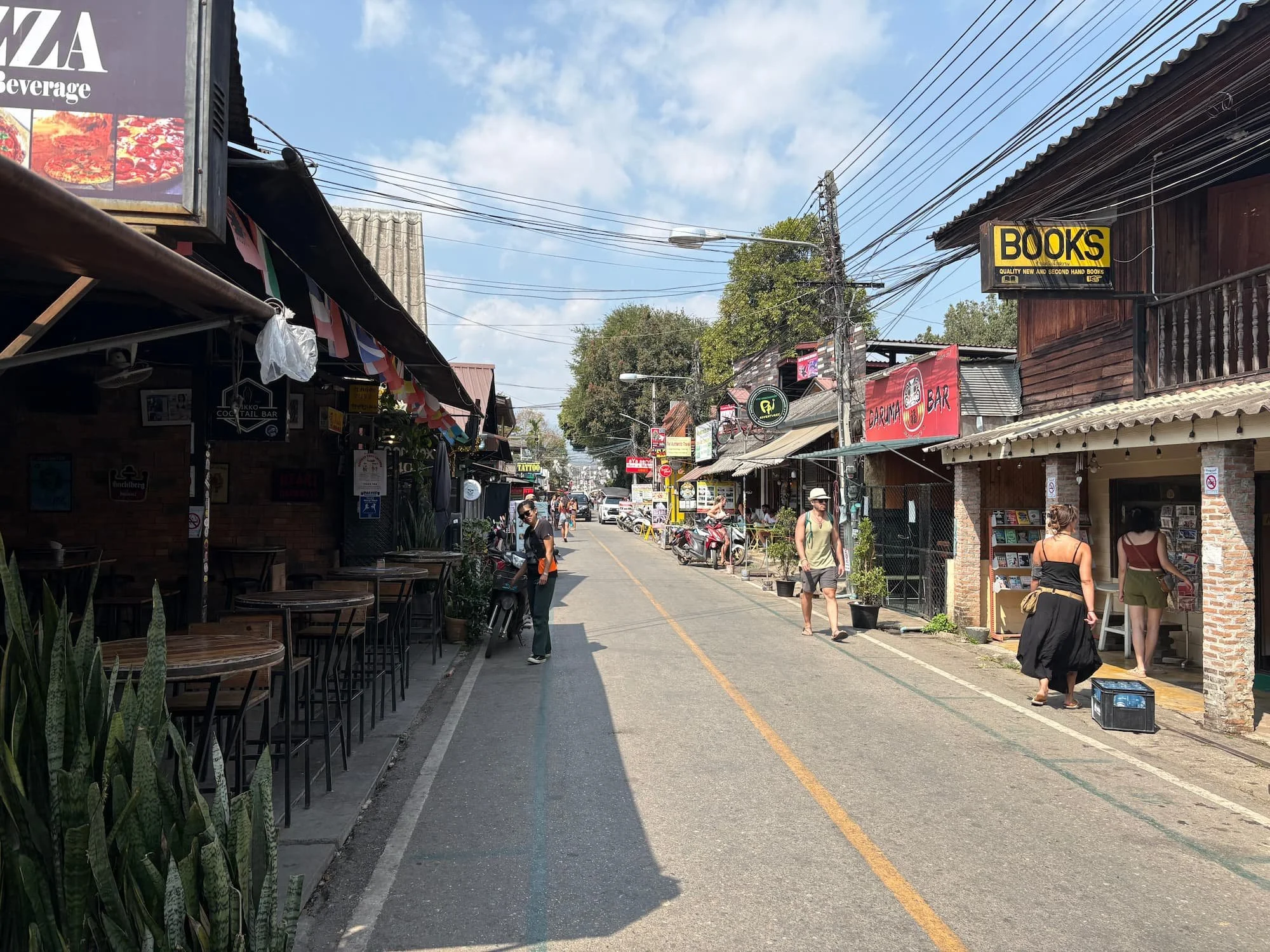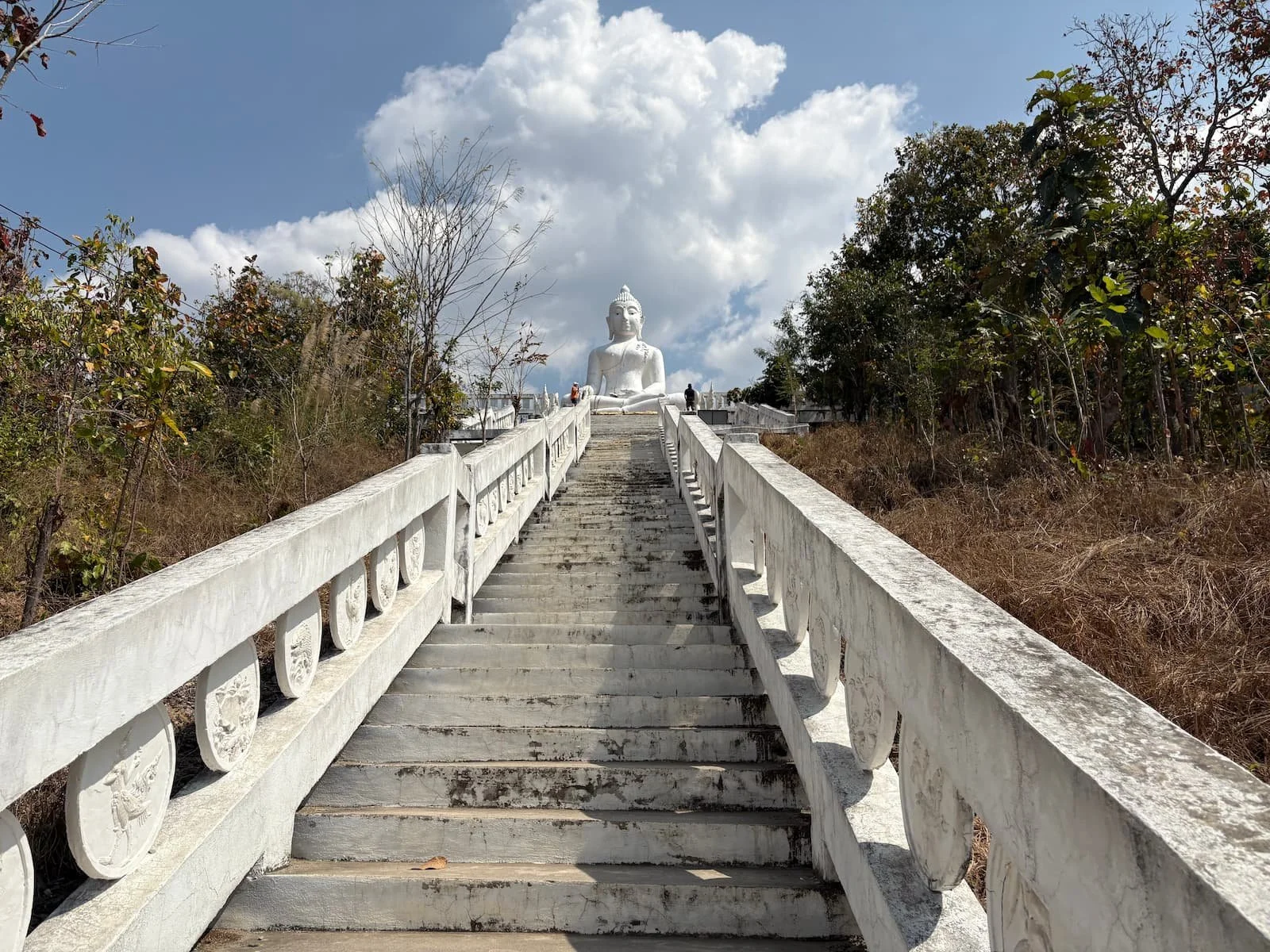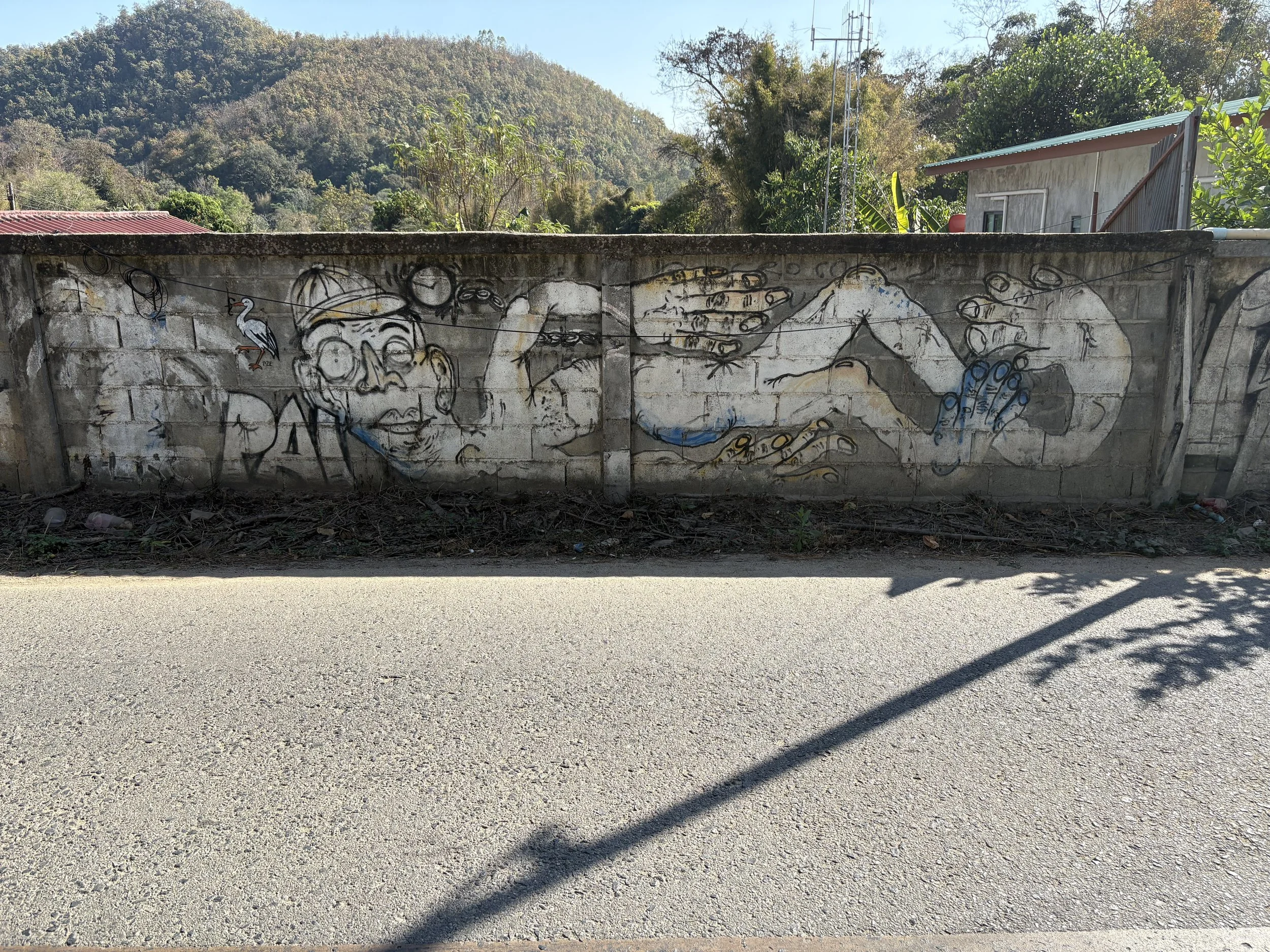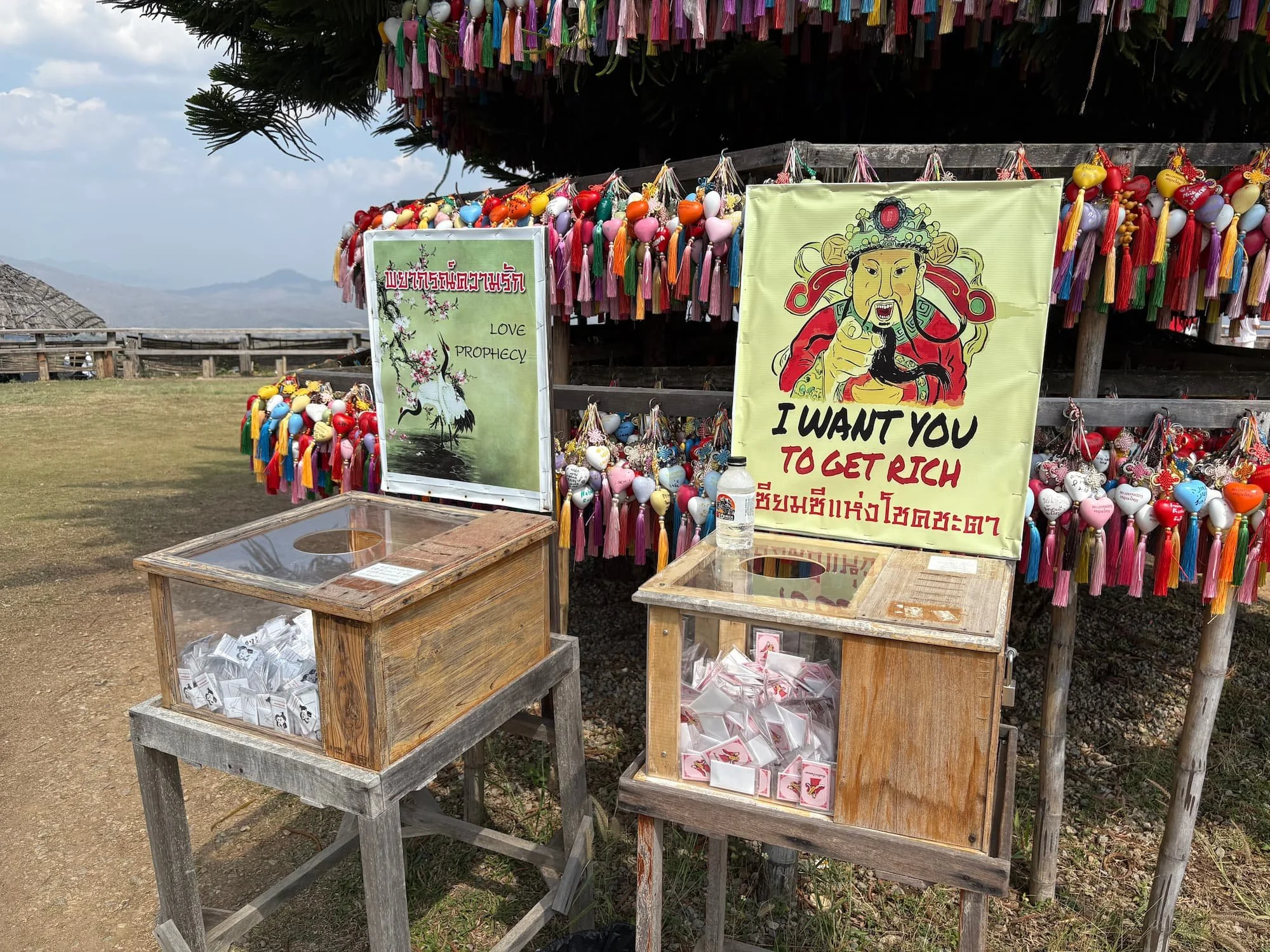3 Days in Pai: Your Perfect Itinerary for Thailand’s Hippie Town (2025 Guide).
Rolling through the mountains from Chiang Mai to Pai felt like I was entering another world…
Where time slows down, people chill out, and scooters and sunsets are the norm!
If you’re planning a shorter trip to the hippie town and wondering how to fill 3 days in Pai, then this blog has got you covered.
From golden sunsets at Pai Canyon and the peaceful White Buddha viewpoint, to natural hot springs, hidden waterfalls, and quirky cafés with mountain views, nature sets the pace here.
The vibe is simple, the people are warm, and the scenery feels endless.
I spent 3 incredible days exploring Pai by scooter, chasing waterfalls, viewpoints, and good vibes in equal measure.
This guide shows you exactly how to spend 3 days in Pai…
Where to go, how to get around, and how to soak up that bohemian magic that makes everyone fall for this little mountain town.
Let’s see if you fall in that infamous Pai Hole!
A quirky cafe in town.
Disclosure: I sometimes use affiliate marketing. This will not cost you anything, but helps with my travel costs. I only recommend companies I use myself.
Mountain Views = Book Early! Best Hotels in Pai for 2025 👇
These boutique stays capture the spirit of Pai, but remember the town fills up in peak season:
Reverie Siam Resort ⭐⭐⭐⭐⭐ – Romantic riverside retreat with vintage charm, mountain views, and a pool that looks straight out of a Bali daydream — my top pick in Pai.
Pai Village Boutique Resort ⭐⭐⭐⭐ – Lush garden setting in the heart of town with wooden cottages, hammocks, and an easy walk to the night market.
Pai Island Resort ⭐⭐⭐⭐ – A tranquil hideaway surrounded by rice fields and bamboo groves, ideal for couples or anyone chasing quiet, scenic mornings.
Chiang Mai to Pai Mini Vans are also in hot demand in peak season - Check here.
Is 3 Days in Pai Enough? (Spoiler: It’s Perfect).
If you plan it right, 3 days in Pai is the sweet spot, enough time to see the best of the valley without losing that relaxed, do-nothing spirit that makes Pai so special.
In three days I visited waterfalls at Pam Bok, climbed to the White Buddha for sunrise views, watched the sky explode over Pai Canyon at sunset, and still had long lazy hours in cafés like Dream Café or Two Huts.
I found it to be the perfect mix of adventure and downtime, with scooter rides through rice fields through the days, and fire shows and live music at night.
Some travellers only visit Pai as a quick side trip from Chiang Mai, it’s one of those places that deserves more than a day.
Three full days let you slow down, explore properly, and understand why so many people arrive for a weekend and stay for much longer!
And if you’re still not sure whether Pai deserves a spot on your Thailand itinerary, my full post Is Pai Worth Visiting? dives deeper into what makes this mountain town so unique.
Slow daytimes in Pai.
What you’ll see in 72 hours.
Three days in Pai might sound short, but trust me, it was enough to experience the magic that keeps travellers hooked on hippie land:
Pai Canyon + sunset views.
Bamboo Bridge (Ko Ku So Bridge).
Wat Phra That Mae Yen (White Buddha).
Pam Bok Waterfall.
Lod Cave day trip.
Pai Hot Springs (Tha Pai or Sai Ngam).
Two Huts or Dream Café sunset spots.
Pai Night Market.
Quirky cafés with mountain views.
👉 Want to explore Pai stress-free? Check this top-rated full-day Pai tour from Chiang Mai — transport, guide, and major highlights included.
Another aesthetically pleasing spot.
Who this itinerary is perfect for.
This 3-day Pai itinerary is ideal for backpackers, couples, and digital nomads chasing slow travel, scenic drives, and mountain-town charm.
It’s perfect if you’re travelling the Chiang Mai to Pai loop, exploring Northern Thailand at your own pace, or just looking to unwind somewhere that feels creative, peaceful, and full of character.
I could have happily spent months in the beautiful town, as it has everything I would need for a productive routine.
A truly unique sunset spot.
This guide’s for travellers who love freedom, coffee with a view, waterfalls, and winding scooter roads…
If you need to escape the fast-pace of your home-life, Pai is incredible.
It was no surprise that the fellow travellers I was meeting were involved with creative enterprises…. Musicians, artists, and fellow bloggers… It is an ideal place to be!
Let’s get into Pai essentials, and then detailed day-by-day itinerary:
I found this place in the woods randomly.
Pai essentials.
Before you pack up your backpack and head north, there are a few things every first-timer should know about Pai…
It’s a small town, but exploring it right makes all the difference, and two things will completely shape your trip: how you get around and where you stay.
Rent a scooter.
Pai was made for scooters….
Everything, from waterfalls and cafés, to sunset viewpoints and Chinese Villages are scattered across the valley, so having your own mode of transport gives you the freedom to explore at your own pace.
Most rentals cost around 150–200 THB per day, with helmets and basic insurance included.
You’ll find countless shops along the walking street; I rented mine from a small local place opposite Pai Village Resort and had no issues at all.
👉 Reserve a reliable scooter or motorbike in advance with full insurance and delivery to your guesthouse here.
Book your Chiang Mai transport in advance.
In peak season, it gets very busy between Chaing Mai and Pai, and the minibuses sell out most days. I had to wait an extra day on one of my visits.
There are so many international backpackers all heading up to Pai as it grows in popularity.
👉 Book a reliable Chiang Mai–Pai minivan with hotel pickup and guaranteed seat here.
My trusty rental.
Pick a beautiful central hotel.
I found choosing the right base made exploring Pai effortless.
Staying near the walking street keeps you within easy reach of cafés, restaurants, and the night market, while still offering quiet corners to unwind.
For a touch of boutique luxury, I loved Pai Village Boutique Resort, which has stylish bungalows, tropical gardens, and one of the best breakfasts in town.
If you prefer riverside tranquillity, Reverie Siam Resort is hard to beat — elegant rooms, mountain views, and a pool made for lazy afternoons.
Budget travellers will love Family House Zen Boutique Resort or Pai Circus Hostel, both central and full of friendly faces.
This hotel sells out weeks in advance every night in peak season!
Day 1 – Arrival, Waterfalls & Sunset at Pai Canyon.
Whether you’ve just survived the 762 curves from Chiang Mai or arrived early from another Northern Thailand stop, your first day in Pai is about getting a taste of what makes this little town so addictive…
Open roads, easy vibes, and beautiful nature everywhere you look!
After checking into your hotel and grabbing a quick lunch, rent a scooter and spend your afternoon exploring Pai’s most scenic spots.
Everything today sits within 20 minutes of town, making it the perfect soft landing into valley life.
👉 If you prefer to relax and enjoy, this tour is perfect, as it covers all the main attractions.
The Golden Buddha in Town.
First stop - Pam Bok Waterfall.
Just outside the town centre, Pam Bok Waterfall is one of Pai’s most refreshing stops.
It’s a narrow gorge surrounded by cliffs, where cool water cascades into a shaded pool, perfect for a quick dip after the morning heat if you visit at the right time of year.
When I visited there wasn’t much water at the main waterfall, so I had to settle for standing under the cascade to cool down in the morning Thailand heat.
There are other spots to have a dip in and around the area.
It’s not the biggest waterfall, or the best Instagram spot in Thailand, but it’s peaceful, local, and a great start to your adventure.
Pam Bok Waterfall.
Bamboo Bridge (Boon Ko Ku So).
A 15-minute scooter ride away lies one of Pai’s most photogenic spots, the Boon Ko Ku So Bamboo Bridge.
Winding for nearly a kilometre across rice fields and farmland, it’s one of those places where you can’t take a bad photo.
I loved how peaceful it felt, and with monks walking quietly between the fields, this felt like an underrated cultural experience, which I enjoyed, although it felt different to my time in Chiang Mai, exploring the temples etc.
Less touristy, more authentic, in a way!
If you keep following the bridge to the end, it leads to a small forest temple where locals come to meditate.
Hardly anyone makes it that far, but it’s worth the walk for the calm alone, it was an awesome way to hit my daily step count.
There’s a small donation box at the entrance (around 20 THB), so bring cash and take your time wandering across.
Some of the best scenery on my whole Asia trip.
White Buddha (Wat Phra That Mae Yen).
Visible from almost anywhere in Pai, the White Buddha, or ‘Wat Phra That Mae Yen’ sits gracefully on a hill overlooking the valley, watching over the town like a guardian.
It’s one of those landmarks you’ll spot from your scooter long before you arrive, I know I did!
The climb is around 350 steps, lined with naga serpent railings and shaded by trees, and though it’ll test your legs, and cardio a bit (in the heat), it’s absolutely worth it.
The higher I got, the more peaceful it felt. Typical of the famous Thai temples, and cultural sites.
A otugh climb in Thailand’s heat.
From the top, the views stretch endlessly across Pai’s rice fields and mountains.
Visiting before sunset is awesome, as it paints everything gold and orange.
I went late in the afternoon, before I headed to Pai Canyon and it felt like the perfect time.
It’s also a deeply spiritual spot for locals.
I saw a few locals quietly praying, and leaving small offerings at the base of the Buddha.
Remember to remove your shoes before climbing the final staircase.
👉 Want a guided ride to Pai’s temples and hidden viewpoints? Check the half-day culture & sunset tour.
Arrived at the top.
Sunset at Pai Canyon (Kong Lan).
End your first day with some active adventure at Pai’s most famous view… Pai Canyon.
This network of narrow ridges and red-earth cliffs glows gold as the sun sets, creating one of the most dramatic scenes in Northern Thailand.
I arrived about 45 minutes before sunset to try and find a good spot, and it was already packed.
If like I do, you love a physical challenge. You can hike along the ridge to find a peaceful place on your own.
I didn’t expect the I didn’t expect the walking trails to be so slippery and uneven, so make sure you wear proper shoes if you plan to explore.
I saw too many backpackers struggling in flip flops!
I climbed up with a cold Thai Tea from the drink stall in the car park, and watched as the whole valley turned into one of those amazing picturesque settings, surreal!
It is a cool spot to meet fellow travellers if you are in the mood also.
👉 Prefer to skip the crowds? Join a small-group sunset tour with hotel pickup and local guide.
An epic evening of adventure.
Day 2 – Lod Cave Adventure & Pai’s Laid-Back Side.
After a full first day of waterfalls and canyons, your second day in Pai takes you deeper into the countryside, along winding mountain roads, through small villages, and into one of Northern Thailand’s most fascinating natural wonders.
This is a slower, more scenic day is part adventure, and part relaxation.
You’ll explore ancient caves in the morning, eat homemade noodles in a hilltop village, and end the day soaking in hot springs before a chilled sunset session at Two Huts.
Some street art in town.
Morning: Scenic ride to Lod Cave.
Start early and head north towards Lod Cave, about a 90-minute scooter ride from Pai.
Similar to the journey from Chiang Mai, it is also a spectacular route, with quiet roads twisting through forested hills, misty valleys, and tiny wooden villages along the way.
Lod Cave, or Tham Lod, is one of the largest cave systems in Thailand and easily one of Pai’s top day trips.
Inside, a local guide will take you through three immense caverns filled with stalactites, ancient coffins, and fluttering bats.
The entrance to Nam Lod Cave.
You’ll hike between chambers and travel part of the route on a bamboo raft, floating gently down the underground river with just the glow of lanterns lighting your path.
It’s a surreal, Indiana Jones kind of experience that was a change from many of the other activities I enjoyed in Northern Thailand.
👉 Prefer not to ride the long distance? Book a guided Lod Cave day tour from Pai — transport, entrance fees, and local guides included.
The bamboo rafts were cool
Lunch stop: at Ban Santichon (Chinese Village).
On the way back to town, stop at Ban Santichon, also known as the Chinese Yunnan Village.
It’s a fascinating little settlement founded by Chinese immigrants who fled Yunnan province decades ago, and it feels completely different to the rest of Pai, and other cities in Thailand.
The streets are lined with clay-brick houses, red lanterns, and symbols of yin and yang painted across archways and walls.
I felt a calm, spiritual energy about the place…
I even spotted a few quirky panda statues tucked between tea shops, a fun contrast to the otherwise traditional setting.
There is a Cantonese vibe throughout the village.
As you would expect, a good reason to stop here is the food…
I ordered a bowl of handmade Yunnan noodles, and some slow-cooked braised pork leg with steamed buns. A little different from my diet on the other days in Pai.
There’s also a short trail leading up to a hilltop viewpoint, where you can sip locally brewed tea and look out over the rooftops and rolling green hills. It’s a quiet, unexpected highlight of the drive back to Pai.
A spirutal corner.
Afternoon: return and unwind at Pai Hot Springs.
I had heard a lot about the hot springs in Pai, so after a long day exploring, it was pretty awesome to go and relax for a while.
It reminded me of my time in La Fortuna in Costa Rica, which is also home to natural hot springs.
You’ll find two main options… Tha Pai Hot Springs, the larger and more popular one with landscaped pools, or Sai Ngam Hot Springs, a smaller, more natural spot nestled in the forest.
I opted for Tha Pai Hot Springs, the larger and more developed option just south of town, and it was perfect.
Natural pools sit among the forest, with steam rising gently through the trees and the sound of the river nearby. Some pools are literally hot enough to boil eggs, while others are comfortably warm for a long soak after a day of riding.
Bring swimwear, a towel, and small change for the entrance fee (around 200 THB), and aim to visit in the late afternoon when the air is a bit cooler.
👉 If you prefer a spa-style soak, check out Pai Hot Springs Resort & Spa — natural pools, private baths, and scenic mountain views.
Pai Hot Springs are popular.
Evening: Chill sunset at Two Huts.
As the day winds down, make your way to Two Huts, another one of Pai’s most beloved sunset spots.
It’s set on the edge of the valley with hammocks, live music, and a bar that serves everything from Thai food to cold beers.
By late afternoon, it fills up with travellers lounging on beanbags, guitars strumming in the background, and the whole sky turning weird colours.
It is another spot that I found just sums up the energy of Pai… Chilled and laidback.
It’s hard to compare the atmosphere here to anywhere else in Thailand.
While Pai Canyon wins for pure adventure, Two Huts takes the crown for vibes. Come for the sunset, stay for the live music you’ll see why everyone falls in love with it.
Live music at Two Huts was awesome.
Day 3 – Café-Hopping, Night Market & Local Vibes.
After two days of chasing waterfalls and sunsets, your final day in Pai is all about slowing down and soaking up the town’s atmosphere.
As much as I loved exploring Pai’s famous spots, Day 3 felt a lot more spontaneous…
Randomly finding scenic cafés, creative corners, and enjoying the laid-back charm that’s made it a backpacker favourite for decades.
I started my morning with a hard Thai boxing session at Pai Fit, before heading off on my scooter to find a cafe for coffee and some relaxation.
Then an afternoon wandering through Pai’s colourful streets built a strong appetite for all the beautiful delights that are available at the night market.
Street food and live music was the perfect way to end 3 epic days in the mountains.
A session at Pai Fit was part of my daily routine.
Dream Café or Coffee in Love: panoramic views, peaceful vibes.
Chiang Mai is Thailand’s best destination when it comes to cafe culture… However, Pai is very close!
Pai does cafés better than most places, not just for the coffee, but for the views.
Every iced coffee, or Thai Tea I enjoyed seemed to come with a backdrop of rolling hills, green rice fields, and the beautiful sunshine!
Dream Café quickly became my favourite spot in Pai.
I found it randomly on my ride, as it’s tucked away among rice fields just outside of town.
With hammocks strung between bamboo poles and cushions scattered under palm-leaf shelters, The vibe is effortlessly chill, exactly what I needed!
As you can see below, the views match the vibes, spectacular!
Amazing afternoon views.
If you prefer something a little more polished and photogenic, Coffee in Love is the classic choice.
Perched high on a hillside overlooking the Pai valley, it’s one of the most famous cafés in town, and for good reason. It’s rustic, but the colourful vibe goes perfectly with the amazing scenery.
It is more touristy here, as many of the popular Pai day tours stop here, enjoying an afternoon coffee and the obligatory photo next to the ‘I am Pai’ sign.
One of my favourite spots.
Another great coffee spot.
Explore Pai town.
After a morning of coffee, calm, and valley views, I spent the afternoon exploring Pai town itself — a colourful little hub that has a bohemian feel to it.
It reminded me of Montezuma in Costa Rica!
It’s small enough to walk end to end in 15 minutes, but it is very easy to get distracted along the way, so it took me a lot longer.
It is filled with art galleries, massage huts, smoothie stalls, and tiny boutiques selling random souvenirs from handmade silver jewellery, to bohemian clothes and essential oils.
Much of it is exactly what you expect to see from a tourist street in Thailand… I had seen them many times before during my time in Bangkok, and especially in Phuket Old Town.
Pai definitely has its own unique character and charm though!
It is it’s easy-going, creative energy that makes the northern town feel different from most of Thailand
Some quirky street art in town.
If you need a breather from the sun, stop at Earth Tone Café, a vegetarian favourite known for its smoothie bowls, kombucha, and shady garden setting.
But if you’re craving something more authentic, head to Khao Soi Zister’s, a small family-run restaurant just off the walking street that serves one of the best bowls of khao soi in the whole of Pai.
👉 Want to stay close to Pai’s cafes, shops, and night market? Check central boutique stays like Pai Village Boutique Resort or Family House Zen Boutique Resort.
Famous Khao Soi dish.
Pai Night Market, street food, and drinks.
After enjoying unique sunsets each night, everyone heads back to town as Pai’s sleepy streets come alive.
Lanterns flicker on, live music performers emerge with their instruments, and the walking street transforms into one of Northern Thailand’s most atmospheric night markets.
Open every evening from around 5pm until 10pm, the Pai Night Market stretches right through the heart of town.
It’s small enough to feel intimate, but packed with flavour, and so much variety! I found this to be a true reflection of Pai’s international backpacker crowd.
Night market scenes.
You’ll find sizzling pad thai made to order, crispy spring rolls, grilled meats, sushi stands, and endless smoothie stalls, all side by side with falafel wraps, wood-fired pizzas, and homemade crepes.
It took me ages, and a couple of full length wanders to decide each night!
My favourites?…
A local stall serving creamy Khao Soi, a tiny lasagne stand that tasted straight out of Italy, and the Nutella-banana crepes that became my nightly ritual.
Grab a plate, find a curb to sit on, and people-watch as travellers and locals mingle, usually outside of one of the 7/11’s.
Pad Thai is beautiful at the night market.
Tasty lasagne.
Once you’ve eaten your fill, wander into one of Pai’s open-air bars or backyard venues.
I stumbled into a small nightclub with a live psytrance DJ, and for a moment it felt like I was back on Koh Phangan, same carefree energy, just surrounded by mountains instead of the sea.
Thailand is famous for nightlife, especially psytance events, so make sure you check one out while in Pai!
A lively nightclub on my first night.
Getting to Pai from Chiang Mai.
When it comes to backpacking Northern Thailand, the road from Chiang Mai to Pai is almost as famous as the town itself… With 762 bends through misty jungle hills and mountain valleys.
You always hear stories of motion sickness and winding turns, but it’s also one of Thailand’s most scenic drives, and half the adventure of visiting Pai.
I’ve done the trip twice…
Once by minivan and once by scooter, and both were unforgettable in different ways.
To make navigating the winding mountain roads easier, I used an eSIM for Thailand so I could access Google Maps and stay connected anywhere between Chiang Mai and Pai…
No SIM shop hassle or lost signal halfway up the hills.
The famous Pai road.
Minivan (most popular):
Fast, cheap, and easy. The 3–4 hour ride costs around 150–200 THB and departs frequently from Chiang Mai’s Arcade Bus Station.
If you’re prone to motion sickness, I suggest taking a tablet before setting off - I did, and it worked like magic! Some of those bends are like a rollercoaster ride!
👉 Book a reliable Chiang Mai–Pai minivan with hotel pickup and guaranteed seat here.
Scooter or Motorbike:
This is the fun option, For confident riders anyway , it’s the ultimate mountain adventure.
There is something special about riding a scooter in Asia, and this route is up there with the best, for sure! Rice fields, forest views, and freedom to stop whenever you like.
It is easy to pick up a scooter in Chiang Mai, and then drop off in Pai when you arrive.
👉 Reserve a quality scooter with insurance and helmets included here.
The Chiang Mai to Pai route is world famous.
Best time to visit Pai.
I visited Pai in February and it was perfect! Here is a breakdown of the different seasons:
The cool season (November–February) is the best time to visit Pai, with clear skies, cool mornings, and golden light over the mountains. It’s also peak season, so book accommodation early.
The green season (June–October) brings lush rice fields, waterfalls in full flow, and fewer crowds, perfect for photography and slow travellers.
March–May is the hot season, with smoky skies from regional burning. It’s less ideal, but still manageable if you plan to relax in cafés or riverside stays.
If you’re visiting Northern Thailand in February, consider pairing your Pai trip with the Chiang Mai Flower Festival — a burst of colour and culture just a few hours away.
Pai’s river is often filled with tipsy tubers.
Pai Itinerary FAQ’s.
Before planning your 3 days in Pai, here are some of the most common questions travellers ask, from how to get there, to where to stay, and when to visit:
How do you get to Pai from Chiang Mai?
The most common way is by minivan or motorbike, which you can book here.
The 762 curves of Highway 1095 are famous (and scenic), taking about 3–4 hours from Chiang Mai. Minivans leave several times daily, while confident riders can rent scooters for the full freedom experience , just make sure your travel insurance covers it.
How many days should I spend in Pai?
3 days in Pai is perfect for most travellers. This leaves enough time to explore the waterfalls, Pai Canyon, bamboo bridges, and the night market without feeling rushed. If you have extra time, you could extend to 4–5 days just to slow down and enjoy the peaceful rhythm.
Is Pai worth visiting from Chiang Mai?
Absolutely. I found Pai to offer a completely different vibe to Chiang Mai, with mountain air, hot springs, and slow living. It’s one of Northern Thailand’s most loved spots for creative travellers, digital nomads, and anyone craving nature and space to breathe.
Where’s the best area to stay in Pai?
Stay close to Pai Walking Street for cafés, bars, and the night market within walking distance.
If you prefer quiet views, choose riverside bungalows or hillside resorts a few minutes outside town, perfect for sunrise views and easy scooter rides.
Where to visit in South East Asia?
If you’re planning to explore beyond Thailand, check out my full guide on Where to Visit in Southeast Asia, with detailed itineraries for Vietnam, Cambodia, and Bali.
Disclosure: I sometimes use affiliate marketing. This will not cost you anything, but helps with my travel costs. I only recommend companies I use myself.

































